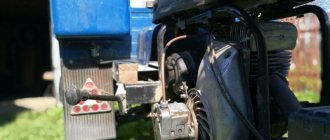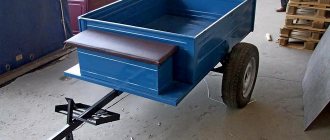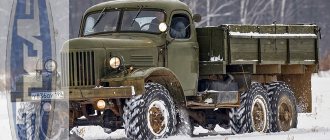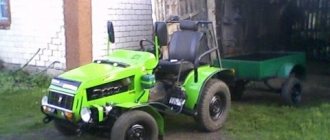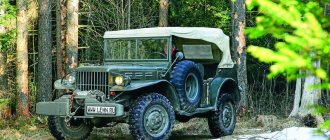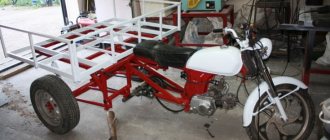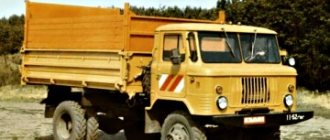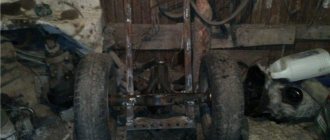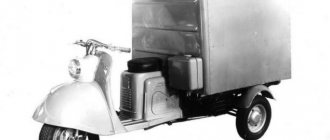Based on the three-wheeled scooter "Ant" you can assemble a full-fledged ATV. These two types of motorcycles have relatively similar characteristics.
The only significant difference is the volume of the gas tank, as well as engine power. The Ant engine is equipped with a multi-disc clutch located in an oil bath. Gasoline is supplied by gravity, and a chain drive is also installed. The engine of this scooter is single-cylinder and has a power of 11 hp. With. The gearbox is four-speed, and the drive is supplied to the rear wheels. The gas tank has a volume of 12 liters, and the average gasoline consumption is about 7 liters per 100 km.
This allows you to assemble an ATV from Ant, which will have characteristics no worse than the factory models .
First you need to prepare the necessary parts and components. Most of them come from a three-wheel scooter, but some parts will need to be purchased or taken from a car.
The tool set includes an angle grinder, a welding machine, and a set of hand tools . To assemble an ATV from “Ant” with your own hands, you will need to work out the drawings yourself. You need to create a diagram with an accurate description of all components, thinking through every detail.
Stages of assembling an ATV
To create a homemade ATV with your own hands, you need to go through 9 stages of work step by step:
- Acquisition and preparation of everything necessary;
- Welding (alteration) of the frame;
- Installation of suspensions, brakes, chassis, shock absorbers, wheels;
- Installation of engine, gearbox, drive assembly;
- Installation of the fuel system;
- Installation of electrical equipment - turn signals, headlights, dashboard, battery;
- Case manufacturing;
- Priming, sanding and painting the body, (if desired) sophisticated custom tuning;
- Installation of the body and seat.
After the final stage, the finished miracle of home-made equipment will need to be thoroughly tested, gradually making road (and off-road) conditions more difficult.
Description of the vehicle
A modern ATV is equipped with four or six small wheels, but with increased maneuverability. The main technical characteristics include: light weight, all-wheel drive and low gear. Due to the unique configuration, the vehicle can easily travel on country roads. It can be used in summer and winter.
To make a homemade ATV, it is recommended to decide on its type:
- Utilitarian. The model has a lot of weight and good maneuverability. The vehicle easily carries several people and accelerates to 90 km/h.
- Stunt. Equipped with a narrow platform and radiator. The car weighs little and can accelerate to 137 km/h.
Do-it-yourself Ant scooter buggy
Dear visitors to the site “ Homemade Friend”, today we will look at step-by-step photos of the assembly of a homemade buggy with components and assemblies of the Domestic cargo scooter “Ant”. Author: Dr 194 on the DRIVE2 website published his Buggy assembled from spare parts from Ant and the Domestic Automotive Industry, a donor was originally purchased for the project and it turned out to be an old motor scooter bought from Grandfather from a neighboring village. The rear part was completely cut off (gearbox, axle shafts, wheels, shock absorbers) without any structural changes built into the back of the buggy. The front suspension, namely the beam, and the wheels were borrowed from the NIVA car, although the author had to shorten it to fit the width of the ant track.
The frame is welded from professional pipes of the following dimensions 40 x 40 x 20 mm, in total 8 pieces were purchased, 6 m each, as well as a profile 50 x 50 mm 6 m 1 piece, gussets 90 mm. Brake discs from Niva were put on the ant's hubs, thereby creating an adapter plate for mounting a car wheel with a radius of 16 R (low-profile bridgestone)
NIVA steering, Ant scooter engine after repair and replacement of rings.
And so, let's look at the design features of the buggy in more detail.
Materials
- Engine and gearbox of cargo scooter "Ant"
- front suspension "NIVA"
- rear suspension "Ant"
- professional pipe 40x40x20 mm 50x50 mm
- gusset 90 mm
- wheels with low-profile tires R-16 (breachstone)
- paint, stickers
Tools
- welding machine
- angle grinder
- drill
- set of wrenches
- plumbing and measuring tools
- skillful hands
Step-by-step photos of assembling a buggy with your own hands. Front suspension from the Domestic car "NIVA" Donor old cargo scooter "Ant" Frame welded from profile 50x50 and 40x40x20 mm Rear part (gearbox, axle shafts, shock absorbers) Ant. The front beam was shortened to match the ant track. Before installation, the engine had to be disassembled and the rings and gasket replaced. A buggy assembled from domestic components and assemblies is more repairable than a buggy assembled from spare parts from foreign cars, and the cost is much lower)
Accessories
It is recommended to use the engine, power and ignition from one scooter so that the entire system functions smoothly. It is advisable to modify some components; for example, it is advisable to equip the ignition system with a battery with characteristics suitable for an ATV. It is better to take the fuel tank from a scooter, as it is large enough for such a system.
The front and rear axles are taken from a cargo scooter, since they are subject to heavy loads. If these system elements are not strong enough, they will quickly deform and fail.
Springs for the shock absorber can be taken from any motorcycle that is large enough. They are fixed on the frame movably, with a configuration resembling the letter “A”. You can purchase shock absorbers separately, as they should provide a smooth ride. New parts perform better than used parts.
Control can be either steering or motorcycle. The choice depends on the taste preferences of the master. The brake lever is connected to the transmission brake, connecting the system to the rear axle sprocket.
Homemade ATV based on Oka and VAZ units
We present the ATV of our regular author S. Pletnev from the city of Ocher, Perm Territory. The next machine he built testifies to the increased design level and professional skills of its creator. However, judge for yourself.
A year of work of 3-4 hours after work and on weekends - and the new car was ready for testing, only minor (and I would say pleasant) modifications remained: connecting lighting equipment, installing an ignition switch, rear-view mirrors and other little things.
Motor
An ATV with a scooter engine will not differ in significant power. But when driving off-road, the driver will be able to get his share of drive. Once the frame is assembled, the motor can be mounted on it. This is a painstaking process that requires accuracy from the master. The motor must fit firmly into its seat. Otherwise, it will be subject to strong vibrations.
The motor shaft must be connected to the gearbox on the rear axle. To do this, you need to attach a chain drive to the gear. The transmission is installed immediately after this, bringing all controls, including those from the engine, to the frame. The pedals and control levers are secured to the appropriate seats.
DIY Oka ATV
The power unit for my homemade ATV was the engine from the Oka car - 32-horsepower, two-cylinder, four-stroke, liquid cooled. And if its power was often not enough for a car, then for an ATV it should have been more than enough.
The machine frame is spatial, welded. Its main elements (two pairs of side members: upper and lower) are made of round pipes of the VGP-25 type (water and gas pipes with a diameter of 25 mm and a wall thickness of 3.2 mm), auxiliary (struts, cross members, etc.) - from VGT-20. The spars are bent: the lower ones are in the horizontal plane, the upper ones are in the vertical plane. I bent the pipes on a pipe bender, “cold”. Eyes (pairs of ears) for attaching suspension arms and shock absorbers were welded to the frame immediately, and various brackets were welded as components and assemblies were installed (in “place”).
The transmission of the all-terrain vehicle is unique. Although the car is all-wheel drive, it does not have a transfer case. As you know, in the Oka the engine is located transversely, while on an ATV it is installed lengthwise. This made it possible to direct the output shafts from the gearbox (Gearbox) not to the right and left wheels (as in a car), but to the front and rear axles. It’s just that the power unit itself, interlocked with the clutch “basket” and gearbox, had to be shifted slightly to the left relative to the longitudinal plane of symmetry in order to reduce the horizontal angle of the longitudinal articulated shafts of the transmission. Well, their vertical angles turned out to be insignificant.
The transmission is assembled from units of various domestic cars, mainly VAZ models. But ready-made industrial units also had to be modified. For example, from the gearbox (from Oka), to ensure optimal (reduced) speed and increase torque, I removed the main gear pair and replaced it with a chain drive. The gearshift rod was also made different - elongated, with outlets on both sides of the gearbox. The rod can be locked in three positions: to engage 1st and 2nd gears, 3rd and 4th and reverse. The lever for selecting these positions is on the right side, and the gear shift lever is on the left.
The inter-wheel gearboxes are from the rear axles of the VAZ “classics”, only their axle shafts along with the “stockings” were removed and replaced with shafts with CV joints from front-wheel drive models. CV joints are also used as hinges in the remaining intermediate shafts of the transmission.
There are no low gears or differential locks.
The steering is motorcycle type (lever and shaft) at the top and automobile type (with tie rods) at the bottom, only simplified, without a steering mechanism, with one bipod. At first I used the steering wheel from a Minsk motorcycle, with a pipe diameter of 22 mm, but it turned out to be a little thin. Later I found and installed it from a Ural motorcycle. The steering shaft is made of a pipe with a diameter of 20 mm and a wall thickness of 2.8 mm. It has a travel stop at the lower end. At the bottom, the shaft rests on a thrust bearing, and in the middle part it rotates in a detachable nylon bracket-sleeve.
The bipod is made of 8 mm thick steel sheet in a shape resembling the letter “T”. At the edge of the “rack” there is a hole with a diameter of 20 mm - the steering shaft is inserted and welded into it, and in the ears there are conical holes for the ball ends of the tie rods. These holes are reinforced with suitable welded washers. The bipod ears are bent down slightly so that they are almost parallel to the rods.
The wheels of the ATV are 15-inch, from a Chevrolet Niva car. Tires with the appropriate landing diameter dimensions 205/70 (width/height as a percentage of the width) with an off-road tread pattern. The wheel running diameter is about 660 mm.
The wheel suspensions are independent, on two triangular wishbones each (upper and lower) with shock absorbers from the Oka car (front). The levers are welded from round pipes of the VGP-20 type. Elastic elements (springs) and shock absorbers are from the Oka
"(rear). Wheel hubs and steering knuckles are welded into the wheel ends of the front arms - from a VAZ-2109 car. Both had to be modified. I installed studs for Niva wheels in the hubs, and homemade swing arms in the front knuckles.
The muffler is homemade, two-section. To protect the body kit from temperature warping, I covered it with a remote cover, and insulated the inlet pipe with asbestos.
Parts selection
ATV frame
Depending on the “donor” and the design of the quad, you either have to make the frame yourself, or you can reconstruct a finished, used one.
The most important thing is that the engine is securely bolted to the bottom along the frame, which can be located either front or rear. The transmission and drive should also be firmly attached to the frame to avoid play.
Homemade frame
The material used is ordinary water and gas pipes with a wall thickness of no more than 3 mm:
- for spars - 25 mm;
- for crossbars and struts - 20 mm.
The pipes are connected using spot welding, followed by solid welding. Ears for attaching shock absorbers and levers are welded to the frame immediately. Brackets - during installation of units and components.
Reconstruction of an existing frame
To reconstruct a finished frame, you should remove everything, leaving the frame, dismantle the back part and build up the front. Then weld elements for fastening a complete set of components and assemblies of the ATV. When reconstructing a motorcycle frame, the seatposts should be moved back by 40 - 45 cm.
The front and rear luggage racks are cut out of a metal sheet and welded to the frame. Finally, the finished frame is painted; there is no need to varnish it.
Additionally, we recommend reading our expert’s article on how to choose a roof rack for your car.
We also recommend reading our specialist’s article, from which you will learn how to select and install a box on the roof of a car.
DIY ATV body kit
Do-it-yourself ATV body kit - fiberglass. I glued it in for the first time, and therefore first studied the recommendations for performing the relevant work. But as it turned out, this process is painstaking, although the result is worth it.
First, I made the required contours of the body kit from a square steel pipe with a cross-section of 10x10x1 mm. Fortunately, this pipe bends easily even with your hands over your knee. The contour was welded to the frame using jumpers from the same pipe, in places where later (after gluing the body kit) the “tacks” could be easily cut off. Then I bent “wings” from hardboard (fibreboard) and fixed them with self-tapping screws to the contour and jumpers. Where the bend turned out to be steep, I attached separate strips of the same hardboard. The front end was made with polystyrene foam purchased at a hardware store. It was possible to use polystyrene foam or the same polystyrene foam, but polystyrene foam turned out to be a more suitable material - it cuts well with a sharp thin knife. I glued individual elements from it into the overall structure on polyurethane foam.
Frame
Creating a case is one of the difficult stages. Suitable materials for this are fiberglass or fiberglass. Sheet metal can also be used, but an artificial body kit will weigh less.
First, a “blank” of the body is cut out of pieces of foam plastic, for which you will need to develop a preliminary drawing. Fiberglass is applied to the prepared form. There will be several layers, so metal fasteners are installed between them for subsequent fixation of the new body kit to the frame. To ensure that each layer is properly bonded to each other, they are additionally coated with epoxy resin. The body needs to be thoroughly dried, and then primed and painted.
After installing all components and connecting the systems, you need to check the functionality and run the vehicle, gradually increasing the load.
Read also: Power steering is hard to turn
The ATV perfectly combines the advantages of a motorcycle with its maneuverability and mobility and a mini-jeep with handling, maneuverability and power. But thanks, among other things, to high demand, buying such an SUV from a warehouse costs a lot of money.
To build an ATV with your own hands - what do you need for this, what components and assemblies, tools and materials? Which “donor” vehicle is suitable, from what components should the quad be assembled? Where to start the assembly and in what sequence should all the work be carried out? Let's figure it out!
How to make an ATV with your own hands is a difficult and responsible task, but feasible for a master who has mastered welding and turning. The effort and time spent are paid off not only by large savings, but also by the result obtained - an exclusive, original model of a quadric that no one else has.
Features of assembling a homemade vehicle highly depend on the chosen base - the engine and other elements that are used by the craftsman.
6 best options for a base (“donor”) for those who have set the goal of how to make an ATV.
- Motorcycle "Ural".
- Motorcycle "Izh".
- Motor scooter "Ant".
- Another motor scooter (scooter).
- Car "Niva".
- Oka car.
Most often, some structural elements are taken from a motorcycle, others from a car.
In addition to the parts (components) for the quadric, its creator will need:
- assembly “shop” - a fairly spacious garage equipped with good heating and lighting will be useful in this capacity;
- a set of equipment and tools;
- blueprints.
DIY ATV frame drawings
The false tank has a complex shape. It was not possible to bend it out of hardboard. Therefore, having wrapped the engine with plastic film, I began to fill the space intended for it with layers of polyurethane foam. After each layer, drying is mandatory, otherwise the thick volume of foam may not dry out inside. Filled until the layers went beyond the contour. Finally, after the foam had completely dried, I began to draw out the desired shape with a knife. The edges were smoothed with coarse sandpaper.
Part of the Oka dashboard was used under the instrument panel. I secured it to the blank also using polyurethane foam. Since the foam is large-porous, the pores were filled with gypsum and then processed. When the shape of the blank began to correspond to the intended design and its surface became more or less smooth, I coated the blank with PF-115 paint. Since I was not going to make a matrix for gluing the body kit on the block, but immediately glued the body kit on it, followed by finishing the surface to an ideal state, putting plaster and painting the block could be neglected.
So, the blockhead is ready and to glue a high-quality product, it was required: 10 kg of epoxy resin, 1 kg of plasticizer for it and 1 kg of hardener, 15 linear meters of thin fiberglass fabric, 5 m of glass mat, brushes, gloves. It is highly advisable to wear breathing protection. And the more expensive they are, the more reliable they are. But, as you know, you can’t buy experience, so I gained it in the process of work.
I used transparent tape as a separating layer between the block and the product. The whole idiot covered it with stripes carefully, without any omissions. It only took 1.5 rolls of wide tape.
I diluted the resin in 200 - 300 grams with a hardener and plasticizer. I used measuring cups and syringes, which is not very convenient. Before this, I cut strips of fiberglass in such sizes that large canvases would lie on flat surfaces, and on uneven surfaces, pieces of fabric could repeat them without making folds. By the way, fiberglass stretches moderately along the diagonal of the weaves, “flowing around” the desired shape.
First, I thickly coated one area of the blockhead with epoxy resin, placed fiberglass on it and impregnated the top with resin again. The adjacent piece of fabric was glued using the same technology with an overlap of 3 - 5 cm. We had to work quickly - the resin sets quite quickly, and the higher its temperature, the faster. Yes, I also heated the resin a little near a powerful lighting lamp for better fluidity.
After covering the blockhead with fiberglass in one layer, I began to cover it with glass mat. The fiberglass mat I got was quite thick, and it turned out to be good for gaining the thickness of the product. But it does not hug uneven surfaces, so I used it only on flat (or slightly sloping) surfaces and without overlap. Impregnation with resin was carried out in the same way as when working with fiberglass. Just keep in mind that it takes a lot of resin to impregnate glass mat, so you need to dilute it more. After gluing the glass mat, uneven surfaces were glued in several layers with cloth. Each subsequent layer was applied after the previous one had set a little, so that the resin would not leak. And since the process of gluing the body kit took more than one day, after a day of break it was necessary to “roughen” the surface with coarse sandpaper and degrease it - after all, the resin cures completely during this time. The final layers on top of the mat were again covered with fiberglass, and not even just one layer.
Since I needed the surface, as they say, the smoother the better, and I didn’t have enough experience, dips and holes still remained - I filled them with resin alone, and with pieces of fiberglass applied there. There wasn't enough resin. I already bought more at the hardware store, in boxes. I liked working with it more because it was already packaged, and all I had to do was mix the ingredients. And it dried faster than the one purchased from the company.
After the glued body kit had completely dried, I made cuts in it, dividing the product into three parts: rear fenders and rear, false tank with seat, front fenders and front end. Carefully, slightly prying and pulling with his hands while picking, he separated the product piece by piece without much effort from the blockhead.
Now, having removed the parts, I began to process them separately, bringing them to the desired result. In general, ordinary preparatory and painting work using “all” technology: first, rough grinding with the removal of large bulges of resin and fiberglass; then painstakingly filling the recesses with putty and fiberglass; then grinding the outer surface and priming with a plasticizer. Finally - metallic painting and varnish with a plasticizer.
The blockhead also carefully cut it off and put it in the far corner - just in case. The body kit was attached to specially made and welded “in place” mounts on the frame.
Finally, I welded front and rear luggage racks from thin-walled steel pipes with an outer diameter of 20 mm, and in addition to them, “kangaroo bars” that replaced the bumpers.
New posts:
Children's electric ATV El-Sport Junior ATV 500W 36V/12Ah
| Speed: | 25 km/h |
| Power: | 500 W |
| Power reserve: | 20 km |
| 60 kg | |
| Weight: | 40 kg |
| Wheel diameter: | 13″ |
| Battery: | |
| Charging time: | 6-8 hours |
| Suspension: | Front and rear spring |
| Drive unit: | Chain |
| Brakes: | Disk |
| Dimensions: | 1020×660×650 |
| Color: | Green, black and white |
| Additionally: | Wheelbase 13x5-6 |
| Type: | Electric ATV |
Price: RUB 36,845 RUB 29,900
Children's ATV with battery El-Sport Kid ATV 800W 36V/12Ah
| Speed: | 25 km/h |
| Power: | 800 W |
| Power reserve: | 20 km |
| 60 kg | |
| Weight: | 40 kg |
| Wheel diameter: | 13″ |
| Battery: | SLA (Lead Acid) 36V/12Ah |
| Charging time: | 6-8 hours |
| Suspension: | Front and rear spring |
| Drive unit: | Chain |
| Brakes: | Disk |
| Dimensions: | 1020×660×650 |
| Color: | Orange |
| Additionally: | Wheelbase 13x5 - 6″ |
| Type: | Electric ATV |
Price: RUB 37,670 RUB 34,500
Children's electric ATV El-Sport Children ATV 1000W 36V/12Ah
| Speed: | 25 km/h |
| Power: | 1000 W |
| Power reserve: | 20 km |
| 60 kg | |
| Weight: | 55 kg |
| Wheel diameter: | 13″ |
| Battery: | SLA (Lead Acid) 36V/12Ah |
| Charging time: | 6-8 hours |
| Suspension: | Front and rear spring |
| Drive unit: | Chain |
| Brakes: | Disk |
| Dimensions: | 1020×660×650 |
| Color: | Green, blue spider |
| Age: | From 4 years |
| Additionally: | Wheelbase 13×5 – 6″ |
| Type: | Electric ATV |
Price: 43,470 rub. 37,900 rub.
Electric quad bike Mytoy 500D
| Speed: | 35 km/h |
| Power: | 500 W |
| Power reserve: | 35 km |
| 90 kg | |
| Weight: | 70 kg |
| Material: | steel, tubular |
| Wheel diameter: | 14″ |
| Battery: | 48V(4x12V)/20Ah |
| Brakes: | |
| Dimensions: | 1150x550x700 |
| Color: | Autumn camo, hip hop, matte khaki, red |
| Shock absorbers: | front/rear |
| Age: | from 4 years |
| Additionally: | Electric motor, brushless, 500 watts, built into the rear axle; Full rear axle differential; Speedometer with battery charge indicator. Front LED headlights. Turn signals; Remote control on/off at a distance of up to 50 meters; Possibility of setting automatic shutdown for 5-10 minutes; Speed limiter from 5 to 35 km/h; Reverse; Pneumatic rubber tires tubeless 14x4,10-6; Reinforced steering rods; Steering hubs on bearings; |
Price: 63,000 rub.
Electric ATV Mytoy 750E differential
| Power: | 600 W |
| Power reserve: | 25 km |
| 100 kg | |
| Weight: | 70 kg |
| Material: | Reinforced steel frame, tubular |
| Wheel diameter: | 16″ |
| Battery: | 48V(4х12V)20Ah |
| Suspension: | Independent front |
| Brakes: | Front/rear manual disc hydraulic |
| Speeds: | Three speed limiters: First speed: 7-9 km/h; Second speed: 12-15 km/h; Third speed: up to 25 km/h; |
| Dimensions: | 1400x760x900 |
| Color: | yellow camouflage, autumn camouflage, maple |
| Shock absorbers: | Oily |
| Age: | from 6 years |
| Additionally: | Electric motor, brushless, 600 watts, built into the rear axle; Full rear axle differential; Speedometer with battery charge indicator; Headlight; Rear stop; Sound signal; Turn signals; Mirrors; Remote control on/off at a distance of up to 50 meters; Possibility of setting automatic shutdown for 5-10 minutes; Reverse; Pneumatic rubber tires tubeless 16×8.00-7; |
Price: 77,700 rub.
Electric ATV Mytoy 500D Lux
| Speed: | 30 km/h |
| Power: | 500 W |
| Power reserve: | 35 km |
| 90 kg | |
| Weight: | 70 kg |
| Material: | steel, tubular |
| Wheel diameter: | 14″ |
| Battery: | 48V(5х12V)/20Ah |
| Brakes: | Rear foot disc hydraulic |
| Dimensions: | 1150x550x700 |
| Shock absorbers: | front/rear |
| Age: | from 4 years |
| Additionally: | Electric motor, brushless, 500 watts, built into the rear axle; Full rear axle differential; Speedometer with battery charge indicator; Silencers-speakers imitating the sound of an engine when you press the gas; Front LED headlights; Turn signals; Remote control on/off at a distance of up to 50 meters; Possibility of setting automatic shutdown for 5-10 minutes; Speed limiter from 5 to 30 km/h; Reverse; Pneumatic rubber tires tubeless 14x4,10-6; Reinforced steering rods; Steering hubs on bearings. |
Price: 69,300 rub.
Electric buggy MYTOY 500W
| Speed: | 30 km/h |
| Power: | 1000 W |
| Power reserve: | 30 km |
| 60 kg | |
| Weight: | 68 kg |
| Wheel diameter: | 13″ |
| Battery: | 48V/20Ah (removable) |
| Brakes: | Disc hydraulic |
| Speeds: | First 5-8 km/h; The second is 15-18 km/h; Third 25-30 km/h |
| Dimensions: | 1330x810x930 |
| Color: | Red Blue |
| Age: | From 7 years |
| Additionally: | Charging indicator; Safety belt; Smooth gas pedal; Reverse speed: (reverse); Seat adjustment (forward, backward); The frame is steel, tubular; Front LED headlights; LED strip around the perimeter; 13x5.00-6″ (rubber, pneumatic, tubeless) |
Price: 82900 rub.
How to make a homemade ATV is a question that is the dream of almost every young designer.
However, not everyone’s dreams of this kind come true and not at the age at which they would like. But sometimes dreamers still make their dreams come true.
Drawing skills, the ability to carry out complex technological processes, the availability of funds and time - these are the basic requirements when creating a homemade vehicle.
Today we will tell you how to construct a homemade ATV using spare parts from Oka and show this process with the help of a photo selection.
You can find out one of the ways and see the reality of creating an ATV yourself from car parts in the example below.
Characteristics of the Ant motorcycle
The dimensions of the Ant are 2680 mm length, 125 mm width and 1075 mm height, the motorcycle base is 1775 mm, ground clearance is 115 mm. The scooters are equipped with an engine with a multi-plate clutch in an oil bath, a chain drive, and the fuel is supplied by gravity. The engine is single-cylinder with a volume of 199 cubic centimeters. Since according to the law it is necessary to register all vehicles with an engine capacity exceeding 50 cubic centimeters, you will need to immediately take care of obtaining all the necessary documentation for the vehicle.
The engine power of the Ant is 11 horsepower at 5000 rpm. The scooters have a four-speed gearbox and drive to the rear wheels - an oscillating shaft with a cardan joint. The rear suspension is independent on wishbones, the front suspension is wishbone. Average fuel consumption is 6-7 liters per 100 km, with a gas tank volume of 12 liters. The future ATV will have approximately the same characteristics.
The photo shows an ATV from Ant, blooming.ucoz.ru
Wheels
It is better to choose wheel rims from light alloy materials, since otherwise the weight of the vehicle will be significant. You can take wheels from a walk-behind tractor, the tread of which has a rather aggressive pattern. But for a light ATV you should not choose wheels from a car. They are large and heavy, so there will be a high load on the engine.
Frame and engine
The first stage is a small alteration of the frame - reinstallation of the seatposts, welding of a trunk made of thin-walled pipes and alteration of the front part of the frame, followed by the installation of suspensions, axles and wheels on the frame. If it is not possible to use independent suspension with a differential, then the wheels can simply be mounted on an axle with a sprocket. The rear suspension must be installed “classic” along with the knuckles, preferably used ones, since the new knuckles are quite rigid and may be somewhat uncomfortable to use at first. When securing the engine (after screwing it to the frame), it is necessary to connect the engine shaft with a transmission; as a rule, a conventional chain drive is used.
Selection of systems
The brake system uses new parts or with minimal mileage. It is dangerous to install old brakes. The muffler is removed from the old car or made independently from a pipe. If a frame from another machine is used, it must be securely bolted to the bottom of the motor. The power unit is installed at the rear or front. Experts advise securely attaching the drive and transmission to the frame.
If the frame requires reconstruction, the component elements are dismantled. The front part needs to be extended onto the frame. At the next stage, the components of the frame are welded. When reconstructing the frame of a motorcycle, the seatposts are moved back by 40-45 cm. Racks are cut out of metal and welded, which are then fixed to the frame. The resulting homemade quad part can be painted with any paint.
To make your own frame, use a regular pipe with a wall thickness of up to 3 mm. It is better to make the spars from a pipe with a diameter of 25 mm, and the struts from a 20 mm pipe. The elements are fixed by spot and then solid welding. In a similar way, the ears from the levers and shock absorbers are welded to the frame. It is recommended to fix the brackets when installing other components and assemblies.
